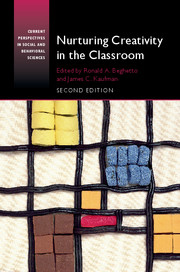Book contents
- Frontmatter
- Dedication
- Contents
- Preface
- Acknowledgments
- PART I VOICES FROM THE FIELD
- PART II VOICES FROM THE RESEARCH
- 5 Developing Creativity Across All Areas of the Curriculum
- 6 Accountability, the Common Core, and Creativity
- 7 Ever-Broadening Conceptions of Creativity in the Classroom
- 8 Creativity in Mathematics Teaching: A Chinese Perspective (An Update)
- 9 Roads Not Taken, New Roads to Take: Looking for Creativity in the Classroom
- 10 The Five Core Attitudes and Seven I's of the Creative Process
- 11 Creativity Embedded into K–12 Teacher Preparation and Beyond
- 12 Attitude Change as the Precursor to Creativity Enhancement
- 13 Nurturing Creativity in the Engineering Classroom
- 14 Intrinsic Motivation and Creativity in the Classroom: Have We Come Full Circle?
- 15 Learning for Creativity
- 16 Creativity and Prosocial Values: Nurturing Cooperation within the Classroom
- 17 How Social-Emotional Imagination Facilitates Deep Learning and Creativity in the Classroom
- 18 Four Faces of Creativity at School
- 19 Teaching for Creativity
- 20 A Coda for Creativity in the Classroom: Take-Home Points and Final Insights
- Index
20 - A Coda for Creativity in the Classroom: Take-Home Points and Final Insights
from PART II - VOICES FROM THE RESEARCH
Published online by Cambridge University Press: 24 November 2016
- Frontmatter
- Dedication
- Contents
- Preface
- Acknowledgments
- PART I VOICES FROM THE FIELD
- PART II VOICES FROM THE RESEARCH
- 5 Developing Creativity Across All Areas of the Curriculum
- 6 Accountability, the Common Core, and Creativity
- 7 Ever-Broadening Conceptions of Creativity in the Classroom
- 8 Creativity in Mathematics Teaching: A Chinese Perspective (An Update)
- 9 Roads Not Taken, New Roads to Take: Looking for Creativity in the Classroom
- 10 The Five Core Attitudes and Seven I's of the Creative Process
- 11 Creativity Embedded into K–12 Teacher Preparation and Beyond
- 12 Attitude Change as the Precursor to Creativity Enhancement
- 13 Nurturing Creativity in the Engineering Classroom
- 14 Intrinsic Motivation and Creativity in the Classroom: Have We Come Full Circle?
- 15 Learning for Creativity
- 16 Creativity and Prosocial Values: Nurturing Cooperation within the Classroom
- 17 How Social-Emotional Imagination Facilitates Deep Learning and Creativity in the Classroom
- 18 Four Faces of Creativity at School
- 19 Teaching for Creativity
- 20 A Coda for Creativity in the Classroom: Take-Home Points and Final Insights
- Index
Summary
As you have seen, essay and chapter authors approached the assignment in several different ways. Some of them talked about their own personal journey with creativity in schools and classrooms. Others used specific, concrete examples of creativity-nurturing curriculum and activities. Some discussed their experiences teaching courses on creativity and the importance of developing new programs to encourage creativity. Still others drew from the latest research and theory to make recommendations for best practices.
A central, recurring theme in the book is the importance of recognizing that creativity can (and should) be cultivated in classrooms (be they early elementary or higher education). The contributors have provided various compelling reasons for why nurturing creativity is an international educational priority. These reasons include everything from complementing academic learning to better prepare future generations to work together to solve increasingly complex personal, social, and global challenges. Many authors also commented on why they feel creativity is often stifled in classroom settings. Unlike other critiques of the educational system, however, the authors in this volume also offer concrete ideas, strategies, and suggestions for addressing the challenges facing teachers interested in promoting creativity. Moreover, the authors in this volume do not blindly advocate for more creativity. Many highlight the risks and costs involved in creative teaching and learning. Taken together, the critiques, insights, and suggestions represent a more balanced treatment of what it means to nurture creativity in the classroom. Some of the ideas and concepts presented are provocative and meant to challenge the way we think about creativity. Others are aspirational and serve as goals we can all strive to attain. Still others are very concrete and actionable – strategies, ideas, and tips that can be incorporated immediately in teachers’ existing curriculum and teaching practices. In what follows we offer our own synthesis of key points that personally resonated with us as educators. We then highlight some other important themes and ideas that recur in these chapters.
- Type
- Chapter
- Information
- Nurturing Creativity in the Classroom , pp. 381 - 384Publisher: Cambridge University PressPrint publication year: 2016

